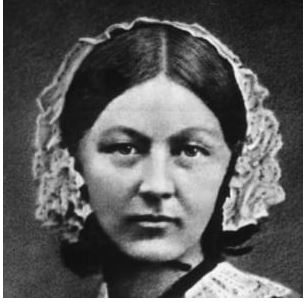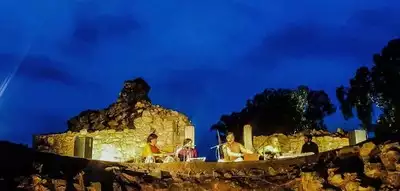Governance
Saansad Adarsh Gram Yojana (SAGY)
Why in News
According to the Ministry of Rural Development, only 252 Members of Parliament (MPs) have adopted gram panchayats under phase-4 of Saansad Adarsh Gram Yojana (SAGY).
- At present, the total strength of both Houses is about 790 which includes elected as well as nominated members.
Saansad Adarsh Gram Yojana
- The scheme was launched by the Prime Minister of India on 11th October, 2014 on the birth anniversary of Jai Prakash Narayan.
- Goal
- Under the Yojana, Members of Parliament (MPs) are responsible for developing the socio-economic and physical infrastructure of three villages each by 2019, and a total of eight villages each by 2024. The first Adarsh Gram (Model Village) was to be developed by 2016, and two more by 2019.
- From 2019 to 2024, five more Adarsh Grams must be developed by each MP, one each year. This implies that a total of 6,433 Adarsh Grams, of the 2,65,000 gram panchayats, will be created by 2024.
- Process
- Gram Panchayat: The basic unit for development.
- Lok Sabha MP: chooses a Gram Panchayat from within his/her constituency.
- Rajya Sabha MP: chooses Gram Panchayat from the rural area of a district of his/her choice in the State from which he/she is elected.
- Nominated MPs: choose a Gram Panchayat from the rural area of any district in the country.
- Action Taken
- The MPs engages with the community, facilitate the Village Development Plan and mobilise the necessary resources particularly from Corporate Social Responsibility (CSR) and philanthropies.
- The planning process in each village is a participatory exercise coordinated by the District Collector.
- MPs also fill up critical gaps in the plan using the Member of Parliament Local Area Development Scheme (MPLADs) funds.
Analysis
- Since the launch of the scheme, only 1,753 gram panchayats have been selected across four phases, way below the expected figure.
- In Phase-1 of SAGY, 703 MPs adopted gram panchayats but that number went down to 497 in Phase-2 and 301 in Phase-3, showing a gradual decline in subsequent phases.
- Specific To Lok Sabha: About two-thirds of Lok Sabha MPs are yet to select gram panchayats under Phase-4 of the scheme. The Lok Sabha has a total strength of 545 members which includes 543 elected members and two nominated members from anglo-Indian community.
Way Forward
- The vision behind the evolution of SAGY villages was to create model villages by ensuring convergence and dovetailing of schemes and its proper implementation on priority basis. However, the seriousness required to achieve the motto is lacking. MPs need to be more responsible towards the scheme.
- At the same time, the Ministry of Rural Development should ensure that the SAGY villages are dealt with the vision envisaged under the scheme and are not left behind.
Jai Prakash Narayan
- Jai Prakash Narayan was born on 11th October,1902 in Uttar Pradesh. He was an Indian political leader and theorist. He is popularly known as Lok Nayak.
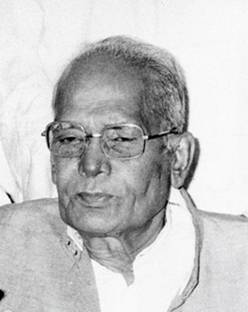
- Narayan was educated at universities in the United States, where he became a Marxist. Upon his return to India in 1929, he joined the Indian National Congress (Congress Party).
- In 1932 he was sentenced to a year’s imprisonment for his participation in the Civil Disobedience Movement against British rule in India. Upon release he took a leading part in the formation of the Congress Socialist Party, a left-wing group within the Congress Party,
- He formed the Praja Socialist Party in 1952.
- Soon becoming dissatisfied with party politics, he announced in 1954 that he would thenceforth devote his life exclusively to the Bhoodan Yajna Movement, founded by Vinoba Bhave, which demanded that land be distributed among the landless.
- In 1974, the students of Gujarat requested him to lead the Nava Nirman Andolan. The same year in June, he gave a call for peaceful “total revolution” wherein he exhorted the students to rise against corrupt political institutions and asked for a closure of colleges and universities and to devote their time to rebuild the nation. It was this time in the history that he was popularly called “JP”.
- This movement finally culminated in the proclamation of Emergency and subsequently in the victory of the “Janata Party” which formed the first ever non-Congress Government in the Centre in March 1977. He had the credit of bringing all the Non-Congress Parties under single umbrella of Janata Party.
- As a tribute to this modern revolutionary, the Government of India posthumously awarded him Bharat Ratna, the highest civilian award of the country in 1999.
Science & Technology
Chandrayaan - 3 and Gaganyaan
Why in News
The Indian Space Research Organisation (ISRO) is working simultaneously on the Chandrayaan-3 and Gaganyaan.
Chandrayaan - 3
- As the name suggests, the Chandrayaan-3 is the successor to the Chandrayaan-2 mission and it will likely attempt another soft-landing on the lunar surface.
- It will be almost a repetition of the July 2019 Chandrayaan-2 mission in the configuration of spacecraft, the landing spot on the moon and the experiments to be conducted on the lunar surface.
- Although scores of landers sent by Russia, the U.S. and the Chinese have explored the moon's surface, so far, no other agency has landed in the southern hemisphere of the moon. ISRO hopes to be the first to do so.
- As per ISRO, the total cost of Chandrayaan-3 mission will be over Rs 600 crores. In comparison, the total cost of the Chandrayaan-2 mission was Rs 960 crores.
Gaganyaan
- Gaganyaan, announced by the Prime Minister in August 2018, is the ₹10,000-crore Indian human space flight scheduled for 2022. It is designed to have 3-7 crew members spend 3-7 days in space in a 400-km orbit.
- The first of the two pre-Gaganyaan flights with a humanoid will be launched in 2020-end along with some of the six shortlisted microgravity experiments.
- ISRO has already constituted an advisory committee for the Gaganyaan. ISRO has also identified four astronauts whose training will commence in Russia from January in 2020.
Second Spaceport in Tamil Nadu
- The Tamil Nadu government has started acquiring 2,300 acres of land in Thoothukudi district for ISRO’s second launch port. Currently satellites are launched from the Sriharikota launch centre in Andhra Pradesh.
- Thoothukudi offers a locational advantage to launch towards India’s South. When ready, the new port will handle mainly the Small Satellite Launch Vehicle (SSLV) that is under development. SSLVs are meant to put a payload of up to 500 kg in space.
- The space agency ISRO preferred its second spaceport at Thoothukudi, located on the east coast and near the equator for the following reasons:
- Speed Boost To Rockets: The Earth's rotation provides a speed boost to rockets launched in the eastward direction, and headed for an equatorial orbit around the planet.
- Save Lives: If there is a failure during the launch, then the debris from an explosion would fall directly into the Bay of Bengal instead of land, which would have less impact on damaging property or taking lives. Further, a southern spaceport reduces the distance to the South Pole and ensures access to a vast, unpopulated area below the flight path.
- Fuel Efficiency
- Another advantage of the new spaceport include straight southward launches as the current rockets have to be maneuvered around Sri Lanka.
- At present, once the rocket lifts off from Sriharikota, it flies further east to avoid Sri Lanka and then steers itself back towards the South Pole. This manoeuvre requires more fuel, and for a smaller rocket like the SSLV, this could hamper its limited payload capacity and reduce the rocket’s value for Antrix, ISRO’s commercial ventures operator.
International Relations
WHO Report on Global Tobacco Epidemic 2019
Why in News
Recently, the World Health Organization has released a report which projected a powerful shift in the global tobacco epidemic. The shift is reflected in the decline in the overall global tobacco use and the number of people consuming it.
Key Points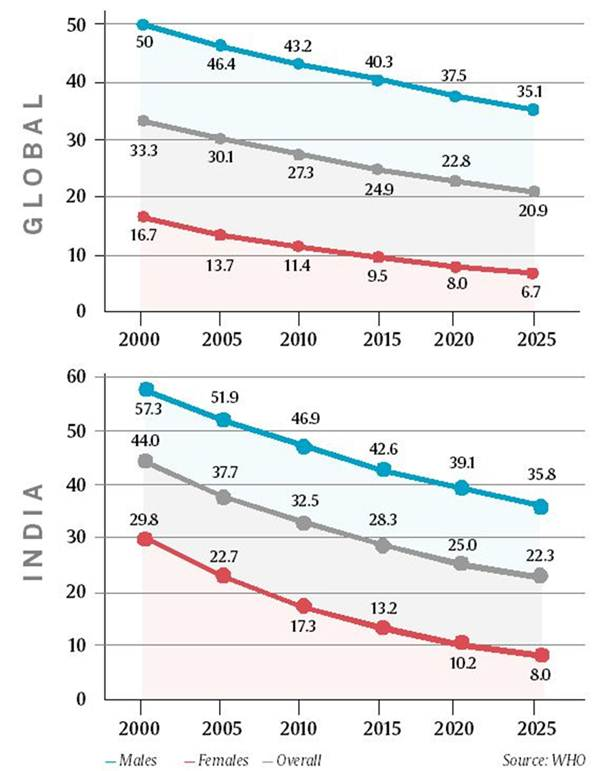
- Number of males using tobacco: It rose from 1.050 billion in 2000 to 1.093 billion in 2018, however, the report projects a decline in the number of males using tobacco.
- The number has stopped growing and is projected to decline by more than 1 million (or 1.091 billion) male users by 2020 and 5 million (or 1.087 billion) less by 2025, compared to 2018 levels.
- Global tobacco use: It declined from 1.397 billion in 2000 to 1.337 billion in 2018.
- The fall was largely driven by reductions in the number of females using tobacco products, with their numbers shrinking from 346 million in 2000 to 244 million in 2018, or more than 100 million users.
- Some 60% of countries have been experiencing a decline in tobacco use since 2010.
- Projections: By 2020, there will be 10 million fewer tobacco users compared to 2018 and another 27 million less by 2025, amounting to 1.299 billion.
- Other findings: Approximately 43 million children (aged 13-15) over the world used tobacco in 2018 (14 million girls and 29 million boys).
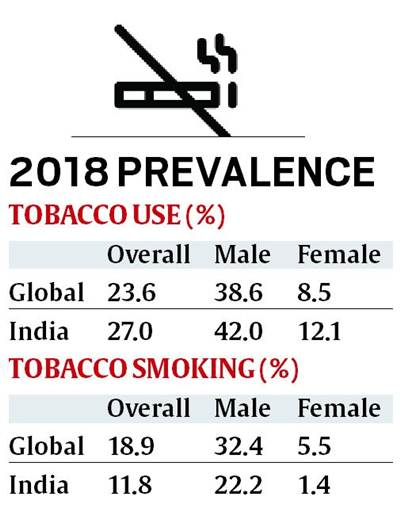
In Indian Context
- In India, the prevalence of tobacco use (male and female combined) in 2000 was 44% and it is expected to reduce almost by half to 22.3% by 2025.
- Globally, the prevalence was 33.3% in 2000, and is projected to reach 20.9% in 2025.
- Current tobacco use rates in India in 2018 for people aged 15 years and older were higher than global rates among both males and females. However, the rates of tobacco smoking were lower than global rates.
Tobacco Control Provisions
- Governments adopt and implement the tobacco control provisions of the WHO Framework Convention on Tobacco Control (WHO FCTC).
- It is the first international treaty negotiated under the auspices of the WHO.
- It was adopted by the World Health Assembly on 21 May 2003 and entered into force on 27 February 2005.
- It was developed in response to the globalization of the tobacco epidemic and is an evidence-based treaty that reaffirms the right of all people to the highest standard of health.
- The FCTC’s measures to combat tobacco use include:
- Price and tax measures.
- Large, graphic warnings on tobacco packages.
- 100% smoke-free public spaces.
- A ban on tobacco marketing.
- Support for smokers who want to quit.
- Prevention of tobacco industry interference.
Biodiversity & Environment
Kerala to Curb Alien Plants’ Growth
Why in News
The Kerala Government is planning to arrest the rampant growth of invasive plants, especially Senna spectabilis, in the forest areas of the Nilgiri Biosphere Reserve (NBR), including the Wayanad Wildlife Sanctuary.
- Due to mass flowering and drying of bamboo species in Wayanad, lots of open spaces (78.91 sq km) has been occupied by Senna spectabilis.
- The plant has also started to invade the adjacent Bandipur and Nagarhole tiger reserves in Karnataka and Mudumalai tiger reserve in Tamil Nadu.
Senna spectabilis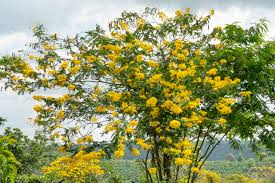
- Senna spectabilis is a deciduous tree native to tropical areas of America.
- It grows up to 15 to 20 metres in a short period of time and distributes thousands of seeds after flowering.
- The thick foliage of the tree arrests the growth of other indigenous tree and grass species. Thus, it causes food shortage for the wildlife population, especially herbivores.
- It also adversely affect the germination and growth of the native species.
- It is categorised as ‘Least Concern’ under IUCN Red List.
Wayanad Wildlife Sanctuary
- It is part of the Nilgiri Biosphere Reserve along with Mudumalai Wildlife Sanctuary, Bandipur National Park, Nagarhole National Park, Mukurthi National Park, and Silent Valley.
- Wayanad Wildlife sanctuary is significant because of ecological and geographic continuity with other protected areas such as Bandipur Tiger Reserve and Nagarhole National Park, of Karnataka in the north-eastern portion and Mudumalai Tiger Reserve of Tamil Nadu in the south-east.
- It has the world’s largest recorded population of the Asiatic elephant.
- Almost the entire Wayanad district is drained by Kabini and its three tributaries, the Panamaram, Mananthavady, and Kalindy rivers.
- The Kabini River, one of the three east flowing rivers of Kerala, is an important tributary of the Kaveri River.
Science & Technology
Satcom Technology Deployed for Learning
Why in News
- Recently, the Rajasthan government has started using satellite communication technology on a broader scale to enhance the learning outcomes in educational institutions and generate awareness about social welfare schemes.
- It will give priority to the five aspirational districts, Karauli, Dholpur, Baran, Jaisalmer and Sirohi, selected by NITI Aayog in the State.
Key Points
- The initiative has been taken to provide the facility of Receive Only Terminals (ROT) and Satellite Interactive Terminals (SIT) for getting the services of subject experts in the government schools and colleges. It will propagate various schemes in remote areas with no internet connectivity.
- At present, there are over hundred SITs and ROTs under CEC EDUSAT network, installed at various colleges, and Universities across the country.
- It will be used in approximately 2,000 institutions coming under various departments, such as education, higher education, social welfare, minority welfare, women and child development and tribal area development.
CEC EDUSAT Network
- The Consortium for Educational Communication (CEC) is one of the Inter-University Centres set up by the University Grants Commission of India.
- It has been established with the goal of addressing the needs of Higher Education through the use of television along with the use of emerging Information Communication Technology (ICT).
- EDUSAT is the satellite exclusively devoted to meet the demands of the educational sector.
- It was launched on September20, 2004, by Indian Space Research Organization (ISRO) to meet the demand for an interactive satellite-based distance education system for the country.
- It has revolutionized classroom teaching through IP based technology.
University Grants Commission
- It came into existence on 28th December 1953 and became a statutory organization of the Government of India by an Act of Parliament in 1956, for the coordination, determination and maintenance of standards of teaching, examination and research in university education.
- The head office of the UGC is located in New Delhi.
Important Facts For Prelims
2020 as Year of the Nurse and Midwife: WHO
Why in News
The World Health Organisation (WHO) has designated the year 2020 as the “Year of the Nurse and midwife”, in honour of the 200th birth anniversary of Florence Nightingale. 
- The declaration of “Year of the Nurse and midwife” will help to strengthen nursing and midwifery for Universal Health Coverage.
- Strengthening nursing will help to achieve Sustainable Development Goals, in particular the (SDG) 3 - ensure healthy lives and promote wellbeing for all at all ages, SDG 5-promoting gender equity and SDG 8- contributing to economic development.
- Nurses and midwives constitute more than 50% of the health workforce in many countries.
- The declaration will also help to endorse “The NursingNow!” a three-year campaign (2018-2020) to improve health globally by raising the status of nursing.
- Moreover, WHO is also leading the development of the first-ever State of the World’s Nursing report which will be launched in 2020.
- Florence Nightingale was a British nurse, statistician, and social reformer who is also considered as a foundational philosopher of modern nursing.
- She was born in Florence, Italy, on May 12, 1820. The year 2020 marks a bicentenary year of her birth.
- During the Crimean War, she and a team of nurses improved the unsanitary conditions at a British base hospital, greatly reducing the death count. Her writings sparked worldwide health care reform.
- She was known for her night rounds to aid the wounded, establishing her image as the 'Lady with the Lamp’.
Important Facts For Prelims
MANI App by RBI
Why in News
The Reserve Bank of India (RBI) has launched a mobile app- Mobile Aided Note Identifier (MANI) to help visually-impaired people to identify the denomination of currency notes.
- There were reports of problems faced by visually-challenged people in identifying new currency notes launched after demonetisation (2016).
- The application can scan the currency notes using the camera of the mobile phone. However, the app does not authenticate a note as either genuine or counterfeit.
- It also gives audio output in Hindi and English.
- The application will work on Android and iOS operating systems. It will work in offline mode once installed.
Important Facts For Prelims
Political Parties Registration Tracking Management System (PPRTMS)
Why in News
The Election Commission of India has launched a “Political Parties Registration Tracking Management System (PPRTMS)”.
- The salient feature in the PPRTMS is that the applicant, who is applying for a political party registration from 1st January, 2020 will be able to track the progress of his/her application and will get status updates through SMS and e-mail.
- Registration of political parties is governed by the provisions of Section 29A of the Representation of the People Act, 1951.
- An association seeking registration under the above mentioned Section has to submit an application to the Commission within a period of 30 days following the date of its formation.
Important Facts For Prelims
Sangita Kalanidhi Award
Why in News
Recently, S.Sowmya has been conferred with Sangita Kalanidhi Award. The award is conferred by the Madras Music Academy.
- It is considered the highest award in the field of Carnatic music.
- The award comprises of a gold medal and a birudu Patra (citation).
Madras Music Academy
- Music Conference held along with All India Congress Session in Madras (1927) laid the idea of a Madras Music Academy. Thus it is an offshoot of INC madras session, 1927.
- It plays an important role in promoting Carnatic Music.
Carnatic music
- Carnatic music is a system of music commonly associated with southern India including the states Andhra Pradesh, Telangana, Karnataka, Kerala, and Tamil Nadu, but also practised in Sri Lanka.
- It is one of two main genres of Indian classical music that evolved from ancient Hindu traditions, the other genre being Hindustani music, which emerged as a distinct form because of Persian and Islamic influences in northern India.
Important Facts For Prelims
Mandu Festival
Recently, five day long ‘Mandu Utsav’ was celebrated in Dhar, Madhya Pradesh from 28th December 2019 to 1st January 2020.
- The festival provides a chance to indulge in some adventure activities like ATV bike, paragliding, rifle shooting, parasailing etc. and witness cultural performances by eminent artists.
Mandu City
- It is a world-famous picturesque tourist destination located in Dhar district of Madhya Pradesh and adorned with Afghan architecture surrounded by baobab trees, native to Africa.

